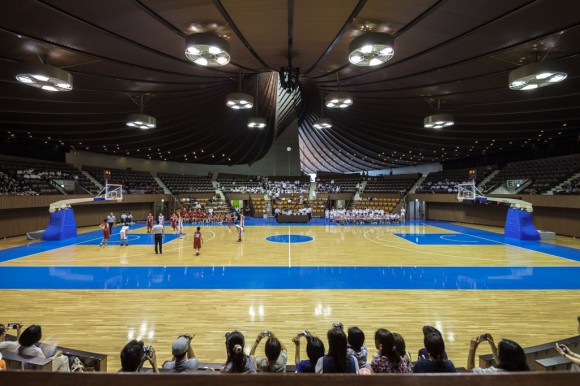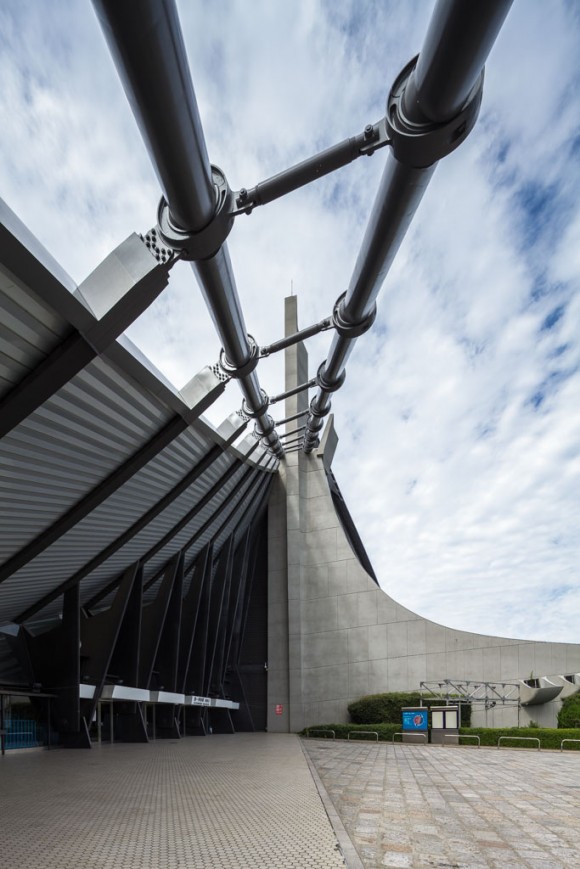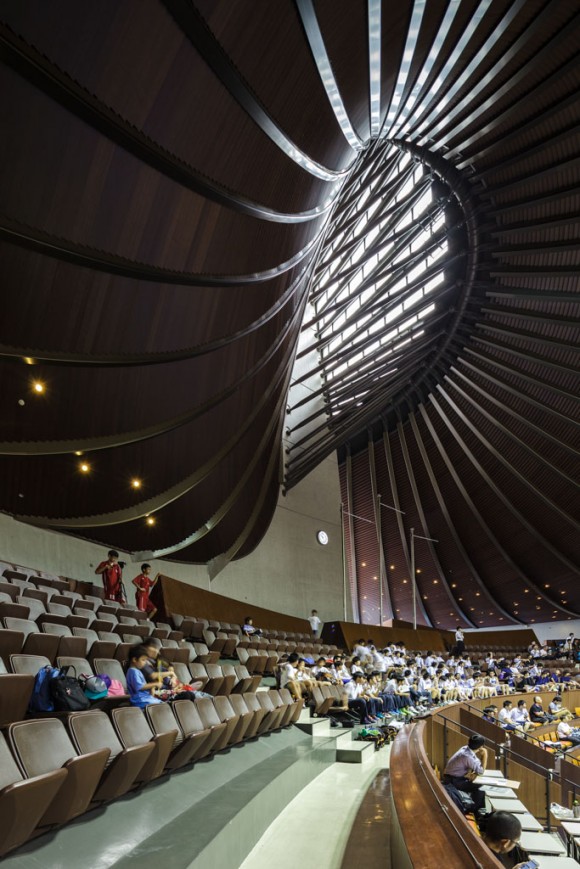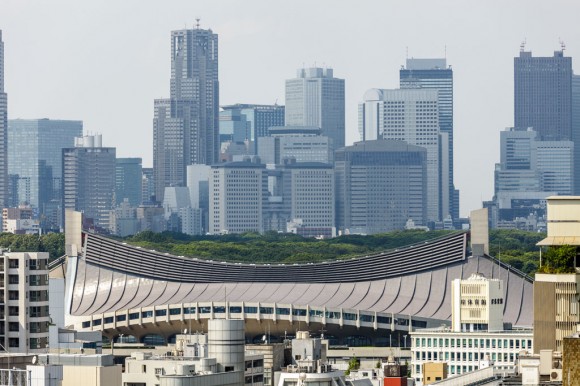Japan’s initial success after the Second World War had a lot to do with the copying of Western technology. The economic miracle of the 1960s, however, rested on Japanese firms’ ever-increasing capability to innovate. The world was to get a taste of this when thousands of spectators visited Tokyo for the 1964 Olympic Games. Kenzo Tange’s Gymnasium provided a central venue of great symbolic power.
All photos by Manuel Oka (www.manueloka.com)
Although the Japanese government had already declared the post-war period to be over in 1956, Japan was a far cry from the country that was to emerge in the decades to come: GDP per capita was only half of the levels seen in West Germany, more than 45% of the population belonged to the primary sector (i.e. agriculture and mining) and only very few goods Japan produced were competitive on the world market, mainly textiles and sundries. Japan recovered the ground it had lost during WWII. While it was not a developing country per se, it was by no means a rich country yet either.
Only eight years later, in 1964, the image of Japan would be radically transformed. Thousands of visitors from around the world flocked to Tokyo for the Summer Olympics. This was no simple undertaking during those days. The age of jet-powered civil aviation had just begun a decade earlier, and still, planes from Western Europe usually made several refuelling stops en route, also to avoid Soviet or Chinese airspace. The “Polar Route” via Alaska’s Anchorage, offering semi-direct flights, was not used widely yet. The Olympic flame itself was transported using a YS-11, a Japanese turboprop machine that, although ultimately a commercial failure, gave a foretaste of the Japan’s growing technological prowess.
After their long and tiring flights from overseas, visitors arrived at the newly extended Haneda airport’s international terminal located in the south of Tokyo. On their way into the city centre, many took the brand-new Monorail, which had begun its service a few weeks before. Spectators from Japan’s second city Osaka likely arrived at Tokyo Station on the shinkansen bullet train, the world’s first high-speed rail project that had also just opened in time for the Games. Those who preferred to take taxis instead zoomed along the newly opened inner ring of the metropolitan expressway, an elevated multi-lane highway that was built on top of major thoroughfares in order to ease increasing congestion. From the plane, train or car, Japan looked impressive.
Yet that Japan was on to something on its own, that the country was finding a path to modernity expressed in distinctly Japanese style and that Western technology was developed further in idiosyncratically Japanese ways — all this was perhaps best visible in one of the sporting venues.
The Yoyogi National Gymnasium is a few minutes’ walk from the Harajuku station in Shibuya ward. The visitor to Tokyo may be forgiven for the oversight of this sporting complex — the adjacent Yamamote Line is on lower ground, and without risking a stiff neck, its passengers would not catch a glimpse of it. Likewise is the approach to the gymnasium strangely hidden and requires the crossing of a pedestrian bridge across a major east-west thoroughfare. As soon as one has climbed the stairs to the bridge, though, a magnificent vista on to this building unfolds.
The gymnasium represents the apex of Kenzo Tange’s long career. As the pre-eminent architect in post-war Japan, his many buildings and designs for Tokyo’s urban planning have won him international fame — he was the first Japanese architect to win the Pritzker Prize, often dubbed the Nobel Prize of the profession. He is the founding father of one of the most important movements in twentieth century architecture, Metabolism. Amongst all of his buildings, the Gymnasium occupies a special place. It is perhaps the most effortless of them all.
The sweeping curves used for the suspended roof create a geometry that appears at odds with the sheer size of the 10,000-visitor arena: upon its completion, Yoyogi National Gymnasium had the largest suspended roof in the world. To accomplish this architectural and engineering feat, a central structural spine holds the structure of the building together. The spine is formed by two 126-meter long steel cables, 13” in diameter each. They are hung between two large towers. Smaller perpendicular wires create the connection to the ground and provide the cover grid for this tent-like, tensile structure.
Tange was inspired by Eero Saarinen’s Ingalls Rink, Yale University’s hockey venue. Finished in 1958, it was built using a very similar structure, yet does not possess the light feel that the National Gymnasium manages to exude. Seen from above, Tange’s work looks almost like a snail. From the outside, each perspective offers a new appearance. Despite its unmistakably modern form, traditional Japanese elements appear to be woven into the fabric of the Gymnasium, for instance where the towers and the roof cables meet.
Key to making the structure feasible from a technical point of view was Yoshikatsu Tsuboi. Tsuboi had become Tange’s favourite structural engineer since the 1950s, when they both collaborated on the Hiroshima Children’s Library and the Ehime Prefectural Hall. Tsuboi proved to be the only engineer in Japan at the time that could build Tange’s visions with confidence. His ingenuity is representative of a whole generation of Japanese scientists and engineers that was a key driver in the process of technology adoption and advancement. Born in 1907, he studied shell theory and shell structure drawing heavily on groundbreaking work by German engineers.
When Tange proposed suspension systems for the Yoyogi Gymnasium, Yoshikatsu was again called in to help. Upon familiarising himself with the brief and early sketches of Tange, he knew that this commission would require more sophisticated engineering than he had ever accomplished before. With the help of complex and — for the time — highly advanced simulations, he and his team found that the gymnasium would have to be designed on the basis of a semi-rigid suspension system. Special devices were pioneered to guarantee the integrity of the structure during and after the construction, e.g. universal joints and oil dampers.
As the Olympics vividly demonstrated, Japan had become able to reproduce Western technology. More importantly, though, the country also showed increasing aptitude to improve it. The Yoyogi National Gymnasium was a case in point. While its parallels with earlier suspended structures were obvious, it seemingly built upon the original not only in size and technological accomplishment, but also in grace and design.
By the 1950s, just ten years before the Olympics kicked off, hardly anyone could have predicted this. And had Japan followed American advice regarding its economic policy, this technological catch-up may well not have happened at all. A discussion between American and Japanese trade negotiators that took place in Tokyo in 1955 shows why.
The officials had gathered to discuss the two countries’ first post-occupation trade agreement. C. Thayer White, the head of the American delegation, told the Japanese to cut their tariffs on car imports. The US auto industry was the most advanced by far, his argument went, and by importing cars from the US, Japan could focus on the products in which it possessed a competitive edge. In short, White was following the Ricardian logic of comparative advantages, one of the key concepts of classical economics.
By opening up its economy to foreign imports, Japanese carmakers would never stand the chance of competing against their much more advanced American rivals. So the Japanese side, led by chief negotiator Kenichi Otabe, politely responded that the US position in effect meant that Japan should specialise in the production of tuna and leave automobiles (and other industrial products) to the United States. It would also mean giving up on any national development strategy that would see Japan progress by moving up the value chain.
In contrast to what the Americans were suggesting, Japan decided to do it its own way. The government went on to protect its infant auto industry by limiting imports of foreign cars to a laughable $500,000 per year. It later went on and erected high tariff barriers across a wide range of industries, in effect rendering the import of technologically superior goods from abroad prohibitively expensive. All the while, the Japanese government almost completely banned investment by foreign companies on its soil. The US let Japan off the hook also because the Pacific island nation was increasingly needed as a bulwark against communism.
In its protectionist approach, the Japanese followed ideas developed by American and German economists Alexander Hamilton and Friedrich List. Both had lobbied for infant industry protection in their homelands during the nineteenth century. They thought that in order to talk face to face with Great Britain, the dominant power of their times, their nations needed to at least initially protect their fledging industry vis-à-vis British technological superiority.
American and German advisers frequently visited Meiji Japan, which was interested in catching up with the West so it could revoke the Unequal Treaties of the 1850s. The American Model of infant industry protection thus became engrained in Japanese economic thinking ever since and was thus the chosen approach by the country’s bureaucrats after WWII; at a time when the US had apparently already long forgotten the recipe itself had followed during its own industrialisation decades before.
Yet Japanese authorities did much more than just protect its infant industries. They also provided a helping hand in technology adoption. MITI, for example, directly provided the scarce foreign exchange needed to acquire licenses for foreign technology. Alternatively, it often simply imported goods for reverse engineering. Very importantly, MITI would also forgive initial failures if it were convinced of the merit of the firm’s long-term strategy.
The transistor radio serves as a useful example. A still relatively unknown player called Totsuko (renamed “Sony Corporation” in 1958) experimented with the relatively new transistor radio technology. Its technology proved superior to the vacuum tubes that had been used before. Yet the work was intensive and required qualified hands to attach the cables to each tiny transistor. The greater the transistor radio industry grew, the more labour was needed. That was no problem for the Japan of the 1950s and early 1960s. Labour was cheap and abundant. By 1965, still 25% of the national labour force was employed in agriculture.
Totsuko called on MITI to help finance the acquisition of the transistor radio license from AT&T, which at $25,000 seemed rather affordable. Using the Americans’ technology, the company launched its first model, the TR-55, in 1955. While Totsuko proved that it was capable of producing radios of smaller size than its competitors, it was the TR-63 that became Japan’s first export hit, with more than 100,000 units sold on the US market in its launch year 1957 alone. While two years between first product (1955) and commercial success (1957) may not appear overly long, such patience would not have existed if Japan had stuck to its comparative advantage and let American products penetrate the market.
The example of Japan’s first car exports are perhaps even more telling. Today’s car giant Toyota was initially founded as Toyoda Automatic Loom Works and produced exactly that — automatic looms for the textile industry. The company forayed into cars in the 1930s and shipped its first export models to the United States in 1958. One would have hoped that Toyota had stuck to its original trade: the Toyopet was a complete disaster. Overpriced and underpowered, it did not manage to climb the hills near Los Angeles without the engine overheating. The name also seemed strange to many Americans, reminding them of toys and pets instead of a passenger vehicle. By the end of the first year, Toyota had sold 287 cars. By the end of 1960, that number climbed to a paltry 1,913. Toyota decided to pull the plug and ceased its US operations.
But amazingly, Toyota did not give up. It feverishly studied the US market and made improvements to its technology. Five years later, the Corona launched, followed shortly thereafter by the Corolla. While not perfect, the two models rectified the obvious shortcomings of the Toyopet. Both cars were lighter, went faster and provided reasonable comfort. In 1968, Toyota sold 72,554 units in the US market. The year after, that figure reached 124,356. It took a long time, dedication and perseverance, but the breakthrough was finally reached.
It becomes obvious that Japan’s exports were not world class from day one. The painstaking process of technology adoption could take place because the government shielded its industry from foreign competition and because initial failure was not seen as a reason to shelve efforts to modernise. Increasingly visible results vindicated those that favoured state intervention and an active industrial policy.
The Olympics in October provided the world with a very tangible snapshot of these developments. Apart from the physical experience of the many foreign visitors to Tokyo, those staying at home could partake in the spectacle too. For the first time in human history, satellite technology broadcasted sporting events around the world in real time. Watchmaker Seiko unveiled its electronic and fully automated timing system, which linked the starting pistol, a quartz-based timer and the photo-finish camera. The apparatus measured times with an accuracy of 1/100th of a second.
The Yoyogi National Gymnasium gave this sensation a spatial manifestation. Japanese architects and engineers were able to build the world’s most daring structures that radiated both boldness and serenity. They had looked abroad for inspiration but were now reconnecting the dots in a quintessentially Japanese way. It proved to be a recipe for success.





